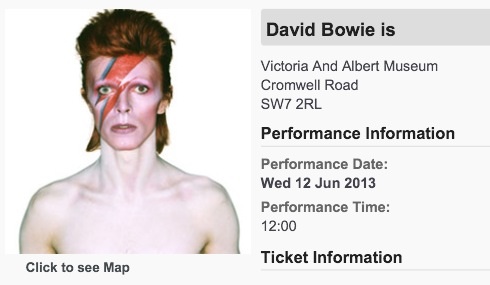I have tickets for us to go see the David Bowie Exhibition at the Victoria and Albert Museum in London which opens today!
The New York Times have written a fabulous article about the exhibition, and since I haven’t been to it yet, I thought I’d just share it
David Bowie Is
Andrew Testa for The New York Times
LONDON — A photograph hangs inconspicuously near the entrance of “David Bowie Is,” a Victoria and Albert Museum exhibition opening on Saturday that has already sold a record number of tickets. It shows the young man who began life as David Jones, seated, in a dark suit and tie, with a leg propped up on his chair, beneath which sits a drum bearing the name of his band, the Kon-rads. One hand grips a saxophone, the other rests delicately against his face, and he looks out at the world with a mesmerizing blend of reserve and come-hither allure.

Mr. Bowie in 1963, at 19, part of the new exhibition “David Bowie Is,” which surveys his career
The carefully choreographed pose, the angelic face, the calculation of the gaze, suggest much about the teenager who would become the protean figure known as David Bowie. Immediately apparent is his understanding of body language, image and the importance of seduction — elements that have played a vital role in the career of a pop star who was a performance artist before that term was widely used.
The idea of an exhibition built around the life and nearly 50-year career of Mr. Bowie is ambitious. How to show the many guises — a new one just provided by the surprise appearance early this month of a new album, “The Next Day” — of a man who throughout his career has relentlessly reinvented his persona and his music with astonishing rapidity and unpredictability? How to make “David Bowie Is” something more than an array of artifacts, from old record covers and photographs to a panoply of costumes and videos? How to suggest the voracious appetite with which Mr. Bowie has both absorbed and anticipated the social and cultural currents of his time?
That the show has happened at all is, on the face of things, unlikely. Mr. Bowie, now 66, is famously guarded. He hasn’t performed in public since 2006, does not give interviews and appears to live as inconspicuously as possible in New York with his wife, the former model Iman, and their daughter. The release of “The Next Day” came as a surprise to almost everyone, including the Victoria and Albert — “although no one believes us,” lamented Geoffrey Marsh, who, with Victoria Broackes, is co-curator of the exhibition.
But toward the end of 2010, the museum received a phone call from an associate of Mr. Bowie’s.
“We were just talking generally about various possibilities,” Mr. Marsh said, speaking in one of the galleries as a video played of Mr. Bowie, in a turquoise suit, singing “Life on Mars.” “Then he said, ‘Are you interested in David?’ ”
It turned out that Mr. Bowie is one of those people who have never thrown anything away. Even better, he believes in organizing everything he has never thrown away. Mr. Marsh and Ms. Broackes traveled to New York to find a 75,000-piece collection that an archivist had spent several years organizing.
“The deal was that we could borrow anything from the archive, but that he would have nothing to do with the exhibition; that all the text must be checked for factual accuracy by the archivist, but the interpretation is ours,” Mr. Marsh said.
Why the intensely private Mr. Bowie, who declined to be interviewed for this article, should have decided at this point to open his archive, life and career to such interpretation is essentially an unanswered question.
“He has had a very long absence from touring, and I think that he doesn’t want to go out on the road, but wants to stay in touch with his audience,” said Kevin Cann, the author of “Any Day Now,” a biography of Mr. Bowie’s early years. “This is him reaching out and sharing.”
To the curators’ credit, “David Bowie Is” — as the open-ended title indicates — attempts something more complex than a single reading of a career that has encompassed an astonishing range of musical and cultural directions. “Discover the recipes you are using and abandon them,” reads one of Brian Eno and Peter Schmidt’s “Oblique Strategies”cards, displayed in the exhibition. That might well be Mr. Bowie’s motto.
From his red-haired, outlandishly costumed, sexually ambiguous incarnation of glam-rock in his 1972 breakthrough album, “The Rise and Fall of Ziggy Stardust and the Spiders From Mars”; to the Weimar cabaret-influenced persona of the Thin White Duke in 1975; to the surrealist Pierrot figure of the 1980 “Ashes to Ashes”; to the Union Jack-coated master (or is he?) of all he surveys on the 1997 “Earthling” album, Mr. Bowie has remained eternally mutable and essentially unknowable.
“Until the Beatles came along, the previous models in rock were that you had a hit, then recycled that until you had bored everyone,” said the music writer Jon Savage in a telephone interview. “I think Bowie picked up that idea of constant change in a more extreme way. Until then, rock music had been about the idea of authenticity, and he shattered that. Saying he was gay at the same time as he had a wife gave the message, this is pop music, this is an area for play, experimentation, have fun. It’s a place outside the norms of society, where you can try different things in a performative way.”
The challenge for “David Bowie Is,” Mr. Marsh said, was to convey the idea of performance and the scope of Mr. Bowie’s cultural references.
“He got the stage, not just as a physical thing but a philosophical thing,” Mr. Marsh said, “and that’s difficult to get over in an exhibition.”
The curators’ decision was to organize the show by theme rather than chronology. The first section is devoted to Mr. Bowie’s early years, displaying photographs, albums and documents. (His favorite authors are “Kafka, Camus, Pinter, Behan, Waterhouse and Wilde,” an early biographical note tells us.)
But the rest of the exhibition is arranged around costumes, songwriting, collaborators and — in a final spectacular display of floor-to-ceiling screens — performance. Mr. Bowie’s music is in the air, throughout, by virtue of headsets worn by visitors that pick up the tracks in each section of the show.
The immersive experience that results seems fitting for an artist described in a telephone interview by the author Camille Paglia as “totally in the senses.” Ms. Paglia, who has contributed an essay to the exhibition catalog, delivered a passionate defense of Mr. Bowie as a major artist and as a counter against what she called the “word-drunk, word-centered, body-phobic” tendencies of postmodernism.
“He is a product of Surrealism, of Dada, of the Modernist arts,” she said. “He is body-based, always completely in the role he is playing. His tremendous physical virtuosity, his understanding of costume and how it is an imaginative projection of your body, is part of the biggest thing about him: he is so deeply emotional. I’m so happy with the return of David Bowie.”
“David Bowie Is” is on view until Aug. 11 at the Victoria and Albert Museum in London.














You lucky duck!! I had this poster which I bought in the UK around 1972………LOL!
LikeLike
Lol, my bedroom wall was covered with his picture. My boyfriends used to get so jealous!
LikeLike
Love me some Bowie! That’s neat that he kept so much stuff. You better post about how you liked it! I have an urge to listen to “Scary Monsters” now because of this.
LikeLike
I will I will I will! 🙂
LikeLike
I remember that bedroom wall and the stars on the ceiling!
LikeLike
The wall was mine, the stars were added later by Jennifer! Can you believe they didn’t have luminous stars when I was decorating it!
LikeLike
Sounds like an interesting exhibit. Enjoy.
P.S. If you see Tilda sleeping there, say hi for me.
LikeLike
I will, I’m hoping to see David Bowie! (Although I might die instantly of excitement)
LikeLike
Lucky you !! So jealous…
LikeLike
I’m so excited, It was so hard to get tickets, the earliest we could get tickets & all go was June! I might just have to stalk out the place between now & then (once the Arctic weather recedes)
LikeLike
Still cold huh ?? We have just had some rain…the first in months really. I have never seen NZ so dry and brown in 20 years of living here.
LikeLike
We’re lucky down south, it’s not been snowy, but freezing, bitter all the same. Hard to believe that this time last year we were sunbathing! Peter’s son lives in NZ, we are hoping to visit sometime eventually!
LikeLike
Well be warned. You will have a very unhappy Kiwi/Aussie sheila should you not pop in to her abode in Katikati !!!!
LikeLike
🙂 I will I promise!
LikeLike